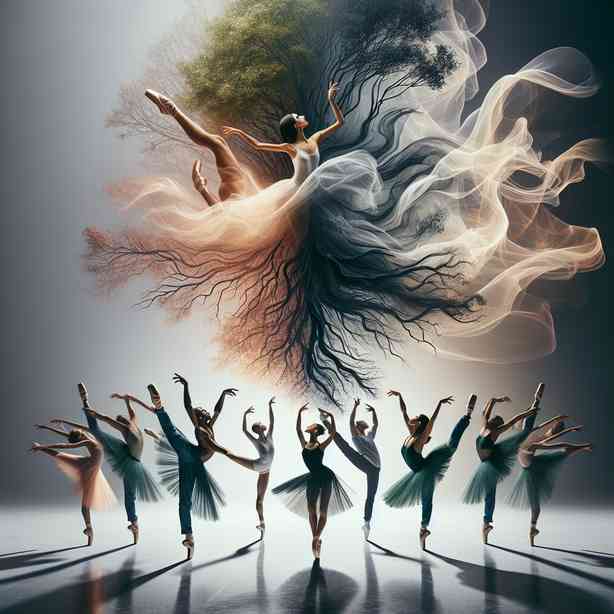
Breathing is often regarded as a fundamental aspect of life; it is an automatic, involuntary function of our bodies that we seldom give much thought to. However, when we explore the intricate relationship between breath and movement, we discover a world where breathing becomes a choreographed symphony of physiological and psychological elements. This phenomenon is particularly evident in practices such as dance, yoga, and various martial arts, where the synchronization of breath with movement leads to profound experiences of harmony and mindfulness.
The act of breathing is not merely a biological necessity but a powerful tool that can enhance our physical and mental well-being. In the context of choreographed movement, breath serves as the bridge that connects the body and mind, promoting a heightened sense of awareness and presence. This connection is particularly explored in various forms of performing arts, where performers utilize breath to convey emotions, achieve precision in movement, and create a visceral experience for their audience.
In dance, for example, choreographers often emphasize the quality of breath within their routines. Dancers learn to control their inhalations and exhalations to facilitate fluid movements, enhance expressions, and support their physical endurance. The timing of breath not only affects the quality of movement but also shapes the emotional narrative of the piece being performed. When a dancer inhales deeply before a leap or exhales during a slow descent, these acts of breathing become integral to the storytelling aspect of the performance, eliciting a deeper connection with the audience.
Yoga is another discipline where breath plays a critical role in the rhythmic choreography of the body. The practice of pranayama, or breath control, allows practitioners to harness the life force known as “prana” to enhance their physical and mental state. Each yoga pose (asana) is synchronized with specific breathing patterns, creating a harmonious relationship that promotes mindfulness and concentration. In this setting, breath becomes a focal point that anchors the practitioner in the present moment, helping to cultivate a sense of peace and clarity amidst the chaos of daily life.
In martial arts, the principles of breathing and movement are equally crucial. Traditional practices often incorporate breathing techniques that enhance strength, focus, and energy. The alignment of breath with physical motion not only boosts the effectiveness of techniques but also minimizes the risk of injury. Specific breathing exercises help martial artists achieve a calm and centered state, enabling them to react swiftly and efficiently in high-pressure situations.
The psychophysiological implications of breathing are also significant. Research has shown that controlled breathing can impact our mental state, reducing stress and anxiety while improving focus and cognitive performance. When we engage in choreographed breathing—such as during a dance routine, yoga session, or martial arts practice—we not only develop physical prowess but also enhance our emotional regulation and mental resilience. This is a critical aspect of how breathing can serve as a therapeutic tool for managing various psychological conditions.
Moreover, in the context of modern therapeutic practices, various forms of breath work have emerged, emphasizing conscious breathing techniques to promote healing and self-discovery. Techniques such as Holotropic Breathwork and Wim Hof Method are gaining popularity for their ability to induce altered states of consciousness, facilitating emotional release and personal growth. These practices highlight the transformative potential of breath when intentionally integrated into our lives and considered beyond mere survival instinct.
As we delve deeper into the significance of choreographed breathing, it’s essential to recognize how various cultures and traditions have valued the connection between breath and movement throughout history. Ancient civilizations often employed breath as a spiritual practice, seeing it as a conduit to connect with the divine or the universe. In many spiritual traditions, the act of breathing is viewed as a sacred practice that fosters a union between the physical and metaphysical realms, enabling practitioners to transcend ordinary reality.
In contemporary society, as we become increasingly disconnected from our natural rhythms due to technological advancements and fast-paced lifestyles, reclaiming the art of conscious breathing can serve as a form of self-care. By intentionally incorporating choreographed breathing practices into our routines—whether through dance, yoga, martial arts, or simple mindfulness exercises—we can reconnect with our bodies, cultivate mindfulness, and promote overall well-being.
Understanding how breath can be consciously directed not only elevates the quality of our interactions with movement but also empowers us to navigate our emotions and thoughts with greater ease. Just as a well-choreographed dance requires meticulous attention to timing, rhythm, and connection, so too does our breath require awareness and intention. By prioritizing breath in our movement practices, we can unlock the potential to transform our physical experiences into something profoundly enriching and emotionally resonant.
In summary, as we explore the choreography of breathing, we uncover the beauty of integrating breath with movement in a way that compels attention and nurtures the mind, body, and spirit. Whether through dance, yoga, or martial arts, the conscious act of breathing enhances physical capabilities while fostering a greater sense of emotional stability and mental clarity. By recognizing and embracing the power of breath, we not only enhance our physical practice but also embark on a journey of self-discovery and personal growth. Thus, the art of breathing becomes not just a choreographed motion, but a pathway to a more mindful, connected, and fulfilling existence.


